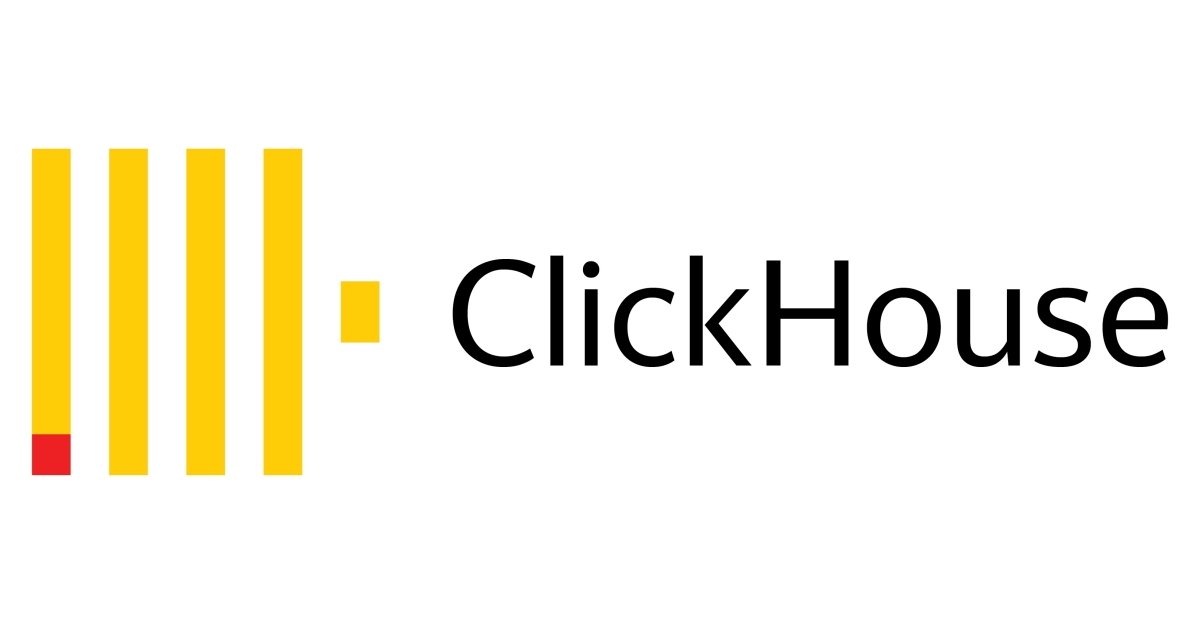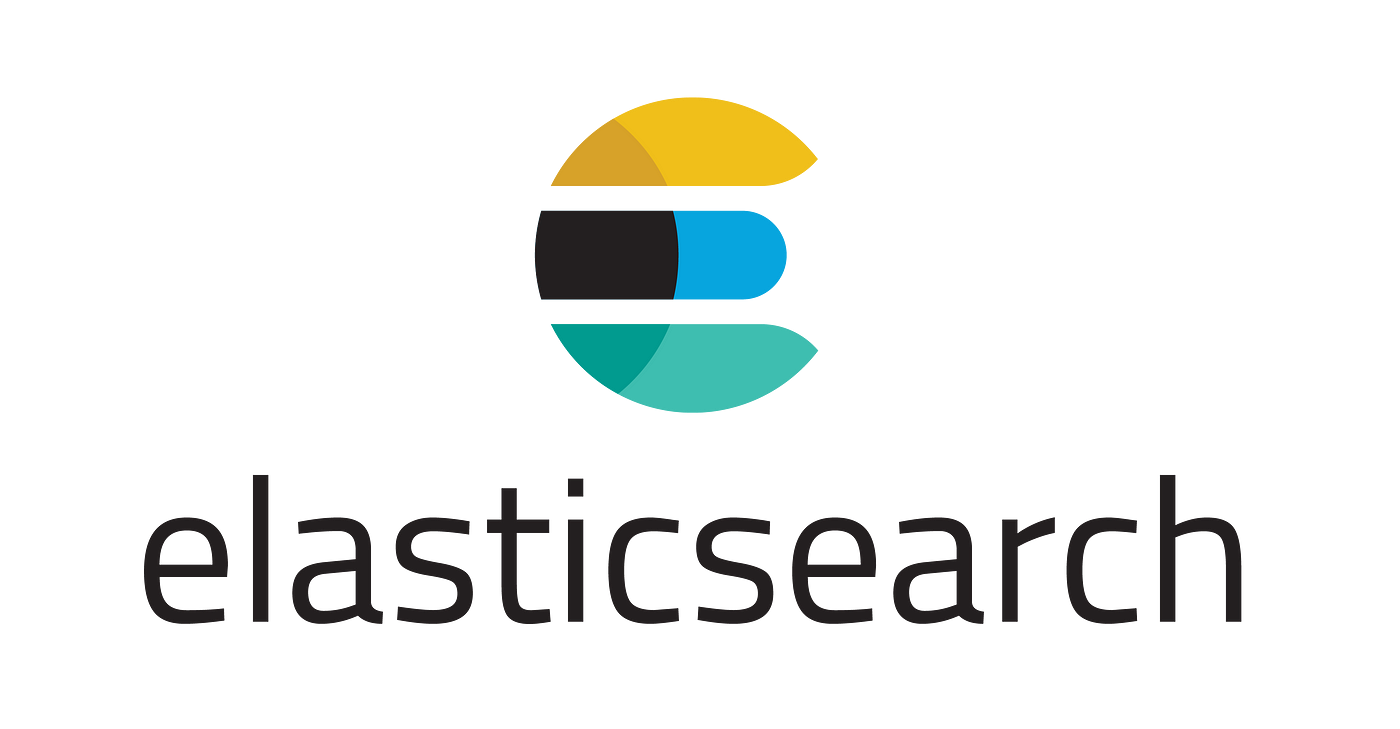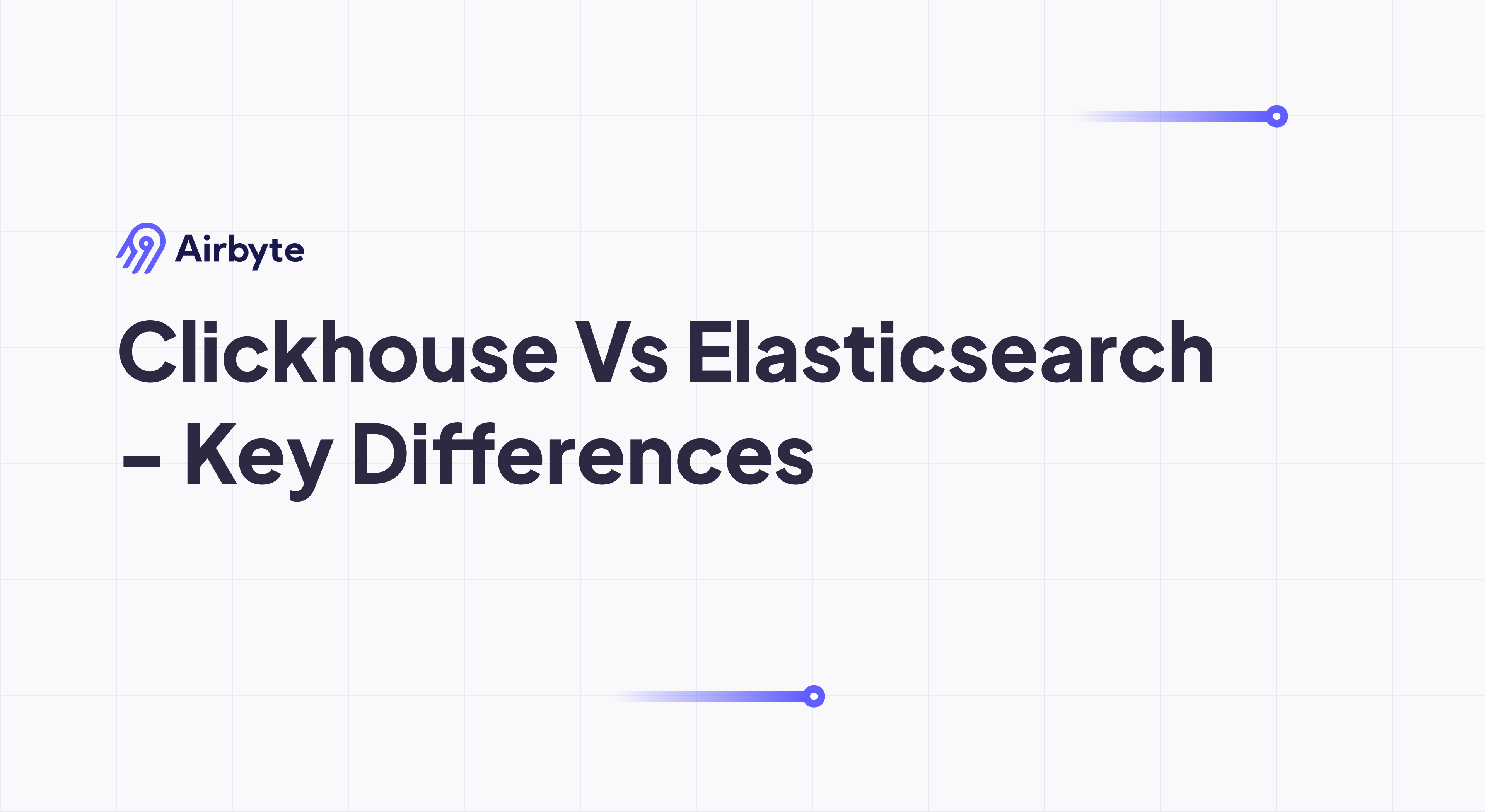ClickHouse vs Elasticsearch – Key Differences
Summarize this article with:
✨ AI Generated Summary
ClickHouse is a columnar, distributed database optimized for real-time analytics and large-scale data processing, supporting SQL queries, fast aggregations, and strong data replication. Elasticsearch is a distributed search engine built on Apache Lucene, excelling in full-text search, real-time indexing, and scalable log and text analysis with JSON document storage.
- ClickHouse suits high-performance OLAP, data warehousing, and clickstream analytics with efficient compression and parallel query execution.
- Elasticsearch is ideal for search engines, monitoring, and log analysis, offering inverted indexing, horizontal scalability, and rich integration plugins.
- Both platforms provide robust security, scalability, and integration options, with Airbyte facilitating seamless data pipeline creation and synchronization between them.
Efficient analysis of your organizational data can provide you with critical insights to help boost decision-making and business growth. To achieve this, you can opt for a data analytics platform like ClickHouse or Elasticsearch.
ClickHouse, a column-oriented database management system, is an ideal choice for real-time query processing. Apart from its capability to handle large data volumes, it also supports fast retrieval and summarization. However, if you’re looking for effective full-text search potential, Elasticsearch is a good option. This search engine offers near-real-time indexing and impressive scalability.
A ClickHouse vs Elasticsearch comparison of crucial features can help you decide which platform will serve your operational needs better. Let’s look into each platform’s highlights!
What is ClickHouse?

ClickHouse is an open-source, highly scalable database management system (DBMS) designed for high-performance online analytical processing (OLAP). It is known for its ability to process large data volumes in real-time at millisecond speeds. This is made possible by its features, such as a columnar store, dynamic materialized views, and specialized engines utilizing multiple cores.
Key Features of ClickHouse
- Distributed Processing on Multiple Servers: In ClickHouse, your data can reside on different shards, with each shard being a group of replicas for fault tolerance. A query will then be run using all shards in parallel, with transparency.
- Real-Time Data Inserts: ClickHouse associates tables with a primary key. If you want to perform queries on the range of the primary key, you can sort the data incrementally with a merge tree. This allows continual addition of data to the table without any locks.
- Vector Computation Engine: Data in ClickHouse is stored by columns and processed by vectors or parts of columns. This enables you to achieve high CPU efficiency.
- SQL Support: ClickHouse supports a SQL-based declarative query language that is identical to the ANSI SQL standard. The different supported queries include window functions, scalar subqueries, GROUP BY, ORDER BY, and subqueries in FROM, among others.
- Data Replication Support: ClickHouse utilizes asynchronous multi-master replication. It maintains identical data on different replicas; when you write data to any available replica, the remaining replicas retrieve a copy in the background. This is beneficial for recovery in the event of failures.
What is Elasticsearch?

Elasticsearch is a popular distributed search and analytics engine built on Apache Lucene, a full-text search library. About 3,256 developers who used Elasticsearch in 2024 want to continue using it, demonstrating its popularity.
Designed as a document-store NoSQL database, the main focus of Elasticsearch is searching and retrieving data; it isn’t commonly used as the primary data storage. Instead, a more traditional database like PostgreSQL often accommodates the data stores, with Elasticsearch being leveraged to improve search results.
Key Features of Elasticsearch
- Supports Varied Data Types: Elasticsearch supports many different data types, including structured, unstructured (JSON), histograms, vectors, text, and shapes, for the fields in a document.
- Performs Full-Text Searches (Inverted Index): It uses a structure called an inverted index that allows very fast full-text searches against large data volumes.
- Scalability: Elasticsearch’s distributed architecture offers horizontal scalability; as your usage grows or you start running out of resources, you can add another node to your cluster for increased capacity and reliability.
- Increased Resiliency: With its support for sharding, automatic node recovery, and rack awareness, Elasticsearch ensures protection against data loss in the event of a failure.
- Data Rollups: Elasticsearch’s rollup allows you to summarize and store historical data and still use it for analysis but at a fraction of the storage costs for raw data.
ClickHouse vs Elasticsearch
The main difference between ClickHouse and Elasticsearch is that ClickHouse is a columnar database optimized for high-speed analytics and large-scale data processing, while Elasticsearch is a search engine designed for full-text search, log analysis, and real-time data exploration.
Infrastructure
ClickHouse uses a shared-nothing architecture to form data clusters from multiple nodes. Each node in a cluster has storage and compute resources. The nodes process data queries independently and in parallel. ClickHouse’s capability to return aggregations, such as sums, averages, and standard deviations, is because of its columnar layout, dynamic materialized views, and specialized engines.
The Elasticsearch architecture is also distributed but document-oriented. This allows you to store data in JSON format and use its inverted index based on Apache Lucene for searchability. Elasticsearch includes clusters and multiple nodes for data indexing, searching, and aggregation.
Data Storage
ClickHouse allows you to store data in tables, utilizing a columnar data store that simplifies data aggregation. It uses methods such as Z Standard (ZSTD) and LZ4 to compress similar data values into columns, reducing storage size and maintaining fast query performance. The data is stored with an inverted structure (in disk) similar to traditional PostgreSQL or MySQL tables.
On the contrary, Elasticsearch isn’t a columnar or even a table-based database. Data storage in Elasticsearch is in the form of documents, with a set of documents grouped into shards. It uses a combination of primary and replica shards. These are a part of physical collections (nodes) and virtual collections (indices). With its LZ4 and DEFLATE compression algorithms, Elasticsearch efficiently meets your data storage size-reduction requirements.
Indexing
ClickHouse indexes are based on an alternative to the B-Tree index, Sparse Indexing. For effective searching and filtering of data, the system arranges structured data as sorted blocks called parts. It involves considering an index for every granule (group of data) instead of every row. Then, a table primary key determines the order of data storage and indexing.
On the other hand, Elasticsearch uses inverted indexing built on Apache Lucene; it’s easier to search for specific terms on documents within large datasets. This is possible since inverted indexing categorizes data into terms, such as words or phrases, and the corresponding document IDs. You can achieve fast search performance for text-based analytics and search queries with these features.
Use Cases
ClickHouse is capable of processing complex queries on voluminous datasets in real-time; you can use it for high-performance data and analytics tasks. Suitable use cases involve data warehousing and clickstream analytics, efficiently managing billions of rows and performing quick aggregations.
However, Elasticsearch, with its Apache Lucene base and inverted index, also offers versatile and real-time search. You can use it to build search engines, monitor your application’s performance, and analyze data logs. It makes it easier for you to identify valuable trends, identify anomalies, and rectify issues for large data volume searches.
Factors to Consider When Choosing ClickHouse or Elasticsearch
Your choice between ClickHouse vs Elasticsearch can involve analyzing multiple factors, from performance and security to scalability and integration capabilities.
ClickHouse vs Elasticsearch Performance
ClickHouse is designed to pre-calculate aggregations in advance to enable millisecond-level fetches for queries. To accomplish this, it uses materialized views and specialized engines optimized for mathematical queries traversing numeric data.
Elasticsearch performs similarly to ClickHouse in certain queries. For instance, you may want to gauge customer sentiment about your products from social media data. Elasticsearch can be useful for this purpose with its capabilities to filter and aggregate data. It involves searching through indices in the inverted index that pattern-match ‘disappointed.’ To know the number of such occurrences, you can add a COUNT() function.
ClickHouse vs Elasticsearch Security
ClickHouse helps secure database access with username/password authentication, Lightweight Directory Access Protocol (LDAP), and OAuth, ensuring access for only authorized users. It also allows administrators to define database, table, and column-level permissions for more granular data access. For additional security, ClickHouse supports encryption of data at rest and in transit, helping protect your sensitive data files on disk. With secure communication over SSL/TLS, ClickHouse provides encrypted data transmission between users and servers.
Conversely, Elasticsearch security features protect storage clusters and data resources. Similar to ClickHouse, it offers authenticated access with username/password authentication and integrates with LDAP and Active Directory. For encryption at transit, Elasticsearch uses SSL/TLS; for encryption at rest, it uses role-based access control (RBAC) and file-level encryption. Elasticsearch also ensures controlled access to documents, indices, and operations by allowing administrators to assign access levels to users and user groups.
ClickHouse vs Elasticsearch Scalability
ClickHouse, with its columnar storage and parallel query execution, is a highly scalable solution for extensive datasets. It involves distributing data across multiple nodes with its distributed system architecture to support horizontal scalability for increasing data volumes.
Elasticsearch is also horizontally scalable; with sharding, you can add more nodes to the cluster for better scalability. It automatically distributes your data and query load across available nodes. With its tightly coupled architecture, compute and storage scale together for improved performance. However, this can result in resource contention and over-provisioning.
ClickHouse vs Elasticsearch Integration and Ecosystem
ClickHouse offers different connectors and APIs for easy data integration. With connectors for popular databases like PostgreSQL, MySQL, and Kafka, it is easy to ingest data from sources. ClickHouse also supports common SQL queries, allowing you to use it with SQL-based tools and frameworks. This enables effortless integration with typical data processing workflows.
On the contrary, Elasticsearch provides you with a robust ecosystem and a wide scope of integration. It includes a variety of plugins for machine learning, visualization, monitoring, and security. Developers can use its RESTful API for programmatic system interaction. Elasticsearch also includes official client libraries for well-known programming languages like Python, Java, and Javascript, making application development easier.
Integrate Your Data into ClickHouse or Elasticsearch with Airbyte

Despite the different offerings of Elasticsearch vs ClickHouse, both platforms have impressive analytical features. However, to harness these features, you must integrate your data with either ClickHouse or Elasticsearch. For an almost effortless integration solution, Airbyte is a suitable choice.
Airbyte is a no-code data movement platform that simplifies the process of building a data pipeline. You can use the Airbyte UI, API, Terraform Provider, or PyAirbyte for building pipelines. With 400+ pre-built connectors, Airbyte provides you with a choice of moving data from varied sources into the destination of your choice.
Since Airbyte supports ClickHouse as both source and destination, you can move data into or out of this platform. A ClickHouse-Elasticsearch connection is also made possible with the available connectors.
Here are some other note-worthy features of Airbyte:
- Change Data Capture (CDC): The CDC feature allows you to identify changes made to your source data and replicate them within the target system with minimal delay. Keeping the source and target systems in sync ensures data consistency.
- Streamlines GenAI Workflows: Airbyte helps simplify your AI workflows by supporting the loading of semi-structured and unstructured data directly into vector store destinations. Some of the Airbyte-supported vector databases include Weaviate, Pinecone, Milvus, and Chroma.
- Supports Custom Transformations: With Airbyte’s dbt Cloud integration, you can create and run dbt transformations after completing syncs. This helps you convert raw data into a suitable format for analysis and reporting.
- Flexible Deployment Options: To run Airbyte, you can consider one of three options: Self-Managed for deployment locally or in an infrastructure user’s setup, Cloud-hosted, and Hybrid.
Summing It Up
A ClickHouse vs Elasticsearch comparison brings out the strengths of each platform for potential use cases.
ClickHouse, with its columnar storage, distributed architecture, and efficient query execution, works well for large-scale data processing and high-performance analytics. On the contrary, Elasticsearch, the flexible search and analytics engine, has full-text search capabilities, inverted index, and near-real-time indexing. This makes it suitable for applications such as text search, monitoring, and log analysis.
To decide between the two, you can analyze certain factors such as performance, security, scalability, and integration capabilities. This will help you make an informed choice for your specific use cases.
Suggested Reads:

